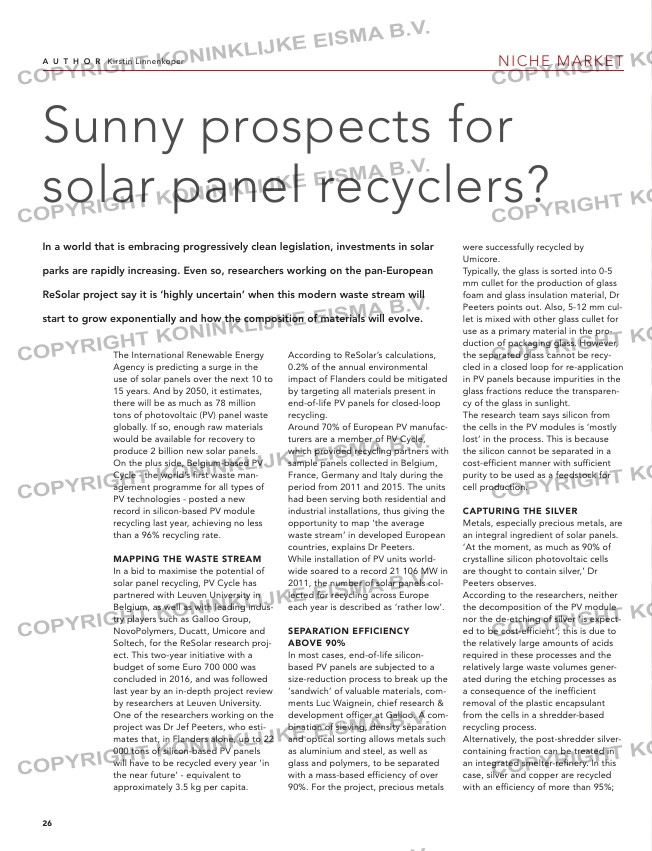Page 26 from: January / February 2018

NICHE MARKET
Sunny prospects for
solar panel recyclers?
In a world that is embracing progressively clean legislation, investments in solar
parks are rapidly increasing. Even so, researchers working on the pan-European
ReSolar project say it is ‘highly uncertain’ when this modern waste stream will
start to grow exponentially and how the composition of materials will evolve.
The International Renewable Energy
Agency is predicting a surge in the
use of solar panels over the next 10 to
15 years. And by 2050, it estimates,
there will be as much as 78 million
tons of photovoltaic (PV) panel waste
globally. If so, enough raw materials
would be available for recovery to
produce 2 billion new solar panels.
On the plus side, Belgium-based PV
Cycle – the world’s first waste man-
agement programme for all types of
PV technologies – posted a new
record in silicon-based PV module
recycling last year, achieving no less
than a 96% recycling rate.
Mapping the waste streaM
In a bid to maximise the potential of
solar panel recycling, PV Cycle has
partnered with Leuven University in
Belgium, as well as with leading indus-
try players such as Galloo Group,
NovoPolymers, Ducatt, Umicore and
Soltech, for the ReSolar research proj-
ect. This two-year initiative with a
budget of some Euro 700 000 was
concluded in 2016, and was followed
last year by an in-depth project review
by researchers at Leuven University.
One of the researchers working on the
project was Dr Jef Peeters, who esti-
mates that, in Flanders alone, up to 22
000 tons of silicon-based PV panels
will have to be recycled every year ‘in
the near future’ – equivalent to
approximately 3.5 kg per capita.
According to ReSolar’s calculations,
0.2% of the annual environmental
impact of Flanders could be mitigated
by targeting all materials present in
end-of-life PV panels for closed-loop
recycling.
Around 70% of European PV manufac-
turers are a member of PV Cycle,
which provided recycling partners with
sample panels collected in Belgium,
France, Germany and Italy during the
period from 2011 and 2015. The units
had been serving both residential and
industrial installations, thus giving the
opportunity to map ‘the average
waste stream’ in developed European
countries, explains Dr Peeters.
While installation of PV units world-
wide soared to a record 21 106 MW in
2011, the number of solar panels col-
lected for recycling across Europe
each year is described as ‘rather low’.
separation efficiency
above 90%
In most cases, end-of-life silicon-
based PV panels are subjected to a
size-reduction process to break up the
‘sandwich’ of valuable materials, com-
ments Luc Waignein, chief research &
development officer at Galloo. A com-
bination of sieving, density separation
and optical sorting allows metals such
as aluminium and steel, as well as
glass and polymers, to be separated
with a mass-based efficiency of over
90%. For the project, precious metals
were successfully recycled by
Umicore.
Typically, the glass is sorted into 0-5
mm cullet for the production of glass
foam and glass insulation material, Dr
Peeters points out. Also, 5-12 mm cul-
let is mixed with other glass cullet for
use as a primary material in the pro-
duction of packaging glass. However,
the separated glass cannot be recy-
cled in a closed loop for re-application
in PV panels because impurities in the
glass fractions reduce the transparen-
cy of the glass in sunlight.
The research team says silicon from
the cells in the PV modules is ‘mostly
lost’ in the process. This is because
the silicon cannot be separated in a
cost-efficient manner with sufficient
purity to be used as a feedstock for
cell production.
capturing the silver
Metals, especially precious metals, are
an integral ingredient of solar panels.
‘At the moment, as much as 90% of
crystalline silicon photovoltaic cells
are thought to contain silver,’ Dr
Peeters observes.
According to the researchers, neither
the decomposition of the PV module
nor the de-etching of silver ‘is expect-
ed to be cost-efficient’; this is due to
the relatively large amounts of acids
required in these processes and the
relatively large waste volumes gener-
ated during the etching processes as
a consequence of the inefficient
removal of the plastic encapsulant
from the cells in a shredder-based
recycling process.
Alternatively, the post-shredder silver-
containing fraction can be treated in
an integrated smelter-refinery. In this
case, silver and copper are recycled
with an efficiency of more than 95%;
a u t h o R Kirstin Linnenkoper
26
26-27-29_solarpanelrecycling.indd 26 25-01-18 17:00



